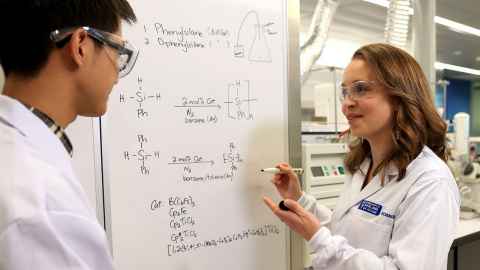Advanced materials and technologies
Materials science addresses many of the challenges facing modern society by developing new substances for use in areas such as sustainable living, the environment, energy and health.

This highly interdisciplinary field of research combines chemistry, physics, biology, medicine and engineering to understand and design desired properties in the development of new substances.
Our research in advanced materials and technologies comprises the synthesis, characterisation and applications of new functional materials including self-assembled peptide systems, polymers, catalysts for energy applications, and novel inorganic/magnetic materials. Electrochemical synthetic methods and studies of material degradation such as corrosion science, are an important part of this work.
Research topics
Solid-state inorganic materials
Inorganic materials have been the backbone of many modern technologies in our daily life. Our researchers study a wide range of materials for use in future applications. They include elements such as magnetically frustrated materials, semiconducting oxides for all-solid-state batteries, fuel cell materials, gas sensors and materials for spintronics applications.
Energy materials and catalysis
Concerns about anthropogenic CO2 emissions from fossil fuels motivates the search for novel and sustainable renewable energy technologies. Our researchers are developing efficient catalysts for the production of fuels via processes such as water splitting, CO2 reduction and N2 fixation. We are also uncovering ways to create an energy-efficient synthesis of new compounds and polymers.
Functional polymeric materials
Both natural and synthetic polymers are part of nearly every activity within modern society. Our staff are working to prepare new, functional polymers for a variety of applications including medical technology, electronics, optics and gas separations. These materials are prepared using versatile approaches to the development of advanced polymer architectures including techniques such as “living” radical polymerisation, redox polymerisation and ring-opening polymerisation.
Bioactive materials and coatings
The inherent biocompatibility and biodegradability of biomacromolecules make them ideal candidates for the design of materials for applications such as drug delivery, tissue-regeneration as well as antimicrobial and antifreeze coatings. Research within the school looks to develop these bioactive materials and coatings for food, medical and biological applications.
Surfaces, including biological systems
Surfaces are of enormous importance for material science with most binding and reactivity events occurring at the surface of solid or solid-like substances such as membranes. Our research explores the development of surfaces with specific properties such as the incorporation of peptides for biosensing applications and understanding the reactivity of surfaces, including oxidative stress on cellular materials.
Electrochemical characterisation and synthesis of materials
The study of corrosion science focusses on the development of in-situ techniques, particularly synchrotron methods, Raman spectroscopy and electrochemical imaging. We study the antioxidant properties of natural and synthetic compounds such as conducting polymers, using electrochemistry and the development of new methods of organic electrosynthesis.
Dynamic microfluidics and nanofluidics
Nanofluidics and microfluidics is the study of fluids confined in sub-micrometre dimensions. Our research uses high-speed photography to study droplet dynamics and electrochemical analysis of the properties of colloids for applications as diverse as water management, bioanalytics and milk powder production.
Our researchers
Professor David Barker
- Functional conducting materials for biological applications
- Synthesis of biologically active materials and coatings.
Distinguished Professor Dame Margaret Brimble
- Biodegradable broad-spectrum antimicrobial agents
- Hybrid self-assembly peptide towards functionalised biomaterials
- Antifouling agents
Associate Professor Daniel Furkert
- Natural product synthesis
- New reaction mechanisms
Professor Christian Hartinger
- Medicinal inorganic chemistry
- Supramolecular chemistry
- Bioanalytical chemistry
Dr Jianyong Jin
- Photopolymers for “living” additive manufacturing
- Polymers for gas separation membranes and gas adsorption
- Biodegradable antimicrobial polymers
Professor Paul Kilmartin
- Electrochemistry
- Conducting polymers
- Sustainable photosensitsers for photocatalysis,
photobiology and photophysics - Supramolecular approaches towards artificial
photosynthesis - Molecular spectroscopy (optical, ultrafast, X-ray)
Dr Erin Leitao
- Bespoke functional polymeric materials
- Catalysts for small molecule activation
Professor Duncan McGillivray
- Nanomaterials
- Surfaces
- Biophysical chemistry
Professor James Metson
- Light metals and their oxides
- Surfaces and catalysis
Associate Professor Gordon Miskelly
- Applications of chemistry in forensic science
- Analytical chemistry
Dr Michel Nieuwoudt
- Photonic devices
- Vibrational spectroscopy and chemometrics
Associate Professor Viji Sarojini
- Antimicrobial materials for biomedical applications
- Self-assembling peptide hydrogels in drug delivery and tissue engineering
- Biomimetically designed materials for energy harvesting
Professor Cather Simpson
- Laser micromachining and microfabrication
- Photonic technology R&D
- Lasers in agtech, primary industries & biomedical diagnostics
Professor Tilo Söhnel
- Inorganic materials chemistry
- Crystallography
Professor Jonathan Sperry
- Electrochemical synthesis
Professor Jadranka Travas-Sejdic
- Polymer bioelectronics
- Conductive biointerfaces
- Conducting polymer functionalization
Professor Geoffrey Waterhouse
- Electrocatalysts for water splitting, fuel cells and batteries
- Solar-driven catalytic reactions
- Carbon dioxide capture and catalytic conversion
Dr Cameron Weber
- Nanostructured fluids as smart materials
- Novel methods of nanoparticle functionalisation
- New catalytic systems
Associate Professor Geoff Willmott
- Wettability, drop impact and capillarity
- Janus colloids
- Mechanics of soft particles